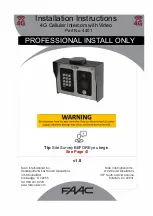
This method of connection uses individual runs of speaker
wire from your amplifier. This doubles the signal carrying
conductors from the amplifier to the speaker, thus direct-
coupling each portion of the crossover to the amplifier.
Connect one set of wires to the upper set of binding posts
which connect to the ESL panel of the Statement e2. Then
connect a second set of wires to the lower binding posts
which connect to the transitions tower. Next, connect both
sets of wires to the appropriate terminals on your ampli-
fier. Please take care to connect both (+) wires to the
(+) amplifier terminals and both (-) wires to the (-)
amplifier terminals. This is known as a parallel connection
(See Figure 48).
Horizontal bi-amping allows you to use two different types,
models or brands of amplifiers (i.e. tubes on top, transistor
on the bottom). However, we recommend that you use
two identical amplifiers (i.e. same brand and model).
If you must use two different amplifiers, it is essential that
they have the same gain or that one of the two have adjustable
gain so that you can match their gain characteristics.
If the amplifiers of choice do not have the same gain
characteristics, then a sonic imbalance will occur.
With horizontal bi-amping, one amplifier drives the high
pass (ESL) section while the second amplifier drives the
low pass (WOOFER) section. Connect the low frequency
amplifier to the lower set of binding posts of both speak-
ers. Connect the high frequency amplifier to the upper set
of binding posts (see figure 49).
Horizontal Passive Bi-Amplification
Figure 49.
Horizontal passive bi-amplification. One Channel shown.
C
ONNECTIONS
—ESL/T
RANSITION
T
OWERS
Bi-Wire Connection
Figure 48.
Bi-wire connection. One Channel shown.
Connections—ESL/Transition Towers 23










































